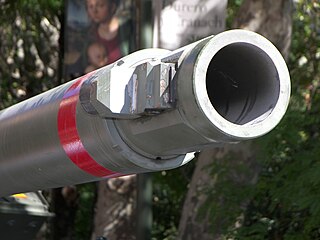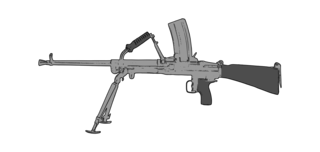
A general-purpose machine gun (GPMG) is an air-cooled, usually belt-fed machine gun that can be adapted flexibly to various tactical roles for light and medium machine guns. A GPMG will typically feature a quick-change barrel design calibered for various fully powered cartridges such as the 7.62×51mm NATO, 7.62×54mmR, 7.5×54mm French, 7.5×55mm Swiss and 7.92×57mm Mauser, and be configured for mounting to different stabilizing platforms from bipods and tripods to vehicles, aircraft, boats and fortifications, usually as an infantry support weapon or squad automatic weapon.

A submachine gun, abbreviated SMG, is a magazine-fed, automatic carbine designed to fire handgun cartridges. The term "submachine gun" was coined by John T. Thompson, the inventor of the Thompson submachine gun, to describe its design concept as an automatic firearm with notably less firepower than a machine gun. As a machine gun must fire rifle cartridges to be classified as such, submachine guns are not considered machine guns.

The Škoda Works was one of the largest European industrial conglomerates of the 20th century, founded by Czech engineer Emil Škoda in 1859 in Plzeň, then in the Kingdom of Bohemia, Austrian Empire. It is the predecessor of today's Škoda Auto, Doosan Škoda Power and Škoda Transportation companies.

The CZ 52 is a semi-automatic pistol designed by two brothers, Jan and Jaroslav Kratochvíl, in the early 1950s for the Czechoslovak military. Around 200,000 vz. 52s were made by Česká Zbrojovka in Strakonice from 1952 to 1954. Before standardizing on the 7.62×25mm vz. 52, the Czechoslovak military used several domestic and foreign pistol models in three different calibers. After 30 years of military service, the vz. 52 was eventually replaced by the 9×18mm Makarov caliber vz. 82.

An anti-tank gun is a form of artillery designed to destroy tanks and other armored fighting vehicles, normally from a static defensive position. The development of specialized anti-tank munitions and anti-tank guns was prompted by the appearance of tanks during World War I. To destroy hostile tanks, artillerymen often used field guns depressed to fire directly at their targets, but this practice expended too much valuable ammunition and was of increasingly limited effectiveness as tank armor became thicker. The first dedicated anti-tank artillery began appearing in the 1920s, and by World War II was a common appearance in many European armies. To penetrate armor, they fired specialized ammunition from longer barrels to achieve a higher muzzle velocity than field guns. Most anti-tank guns were developed in the 1930s as improvements in tanks were noted, and nearly every major arms manufacturer produced one type or another.

The 7.62×25mm Tokarev cartridge is a Russian rimless bottlenecked pistol cartridge widely used in former Soviet states and in China, among other countries. The cartridge has since been replaced in most capacities by the 9×18mm Makarov in Russian service.

The vz. 58 is a 7.62×39mm assault rifle designed and manufactured in Czechoslovakia and accepted into service in the late 1950s as the 7,62 mm samopal vzor 58, replacing the vz. 52 self-loading rifle and the 7.62×25mm Tokarev Sa 24 and Sa 26 submachine guns.

Česká zbrojovka a.s. Uherský Brod (CZUB) is an engineering company based in Uherský Brod, whose main activities include the production of service, hunting and sports firearms. It is owned by the Czech company Česká zbrojovka Group SE, which also owns other companies with related production programmes.

The CZ Model 25 was perhaps the best known of a series of Czechoslovak designed submachine guns introduced in 1948. There were four generally very similar submachine guns in this series: the Sa 23, Sa 24, Sa 25, and Sa 26. The primary designer was Jaroslav Holeček (1923–1977), chief engineer of the Česká zbrojovka Uherský Brod arms factory.
The vz. 24 rifle is a bolt-action carbine designed and produced in Czechoslovakia from 1924 to 1942. It was developed from the German Mauser Gewehr 98 line, and features a very similar bolt design. The rifle was designed in Czechoslovakia shortly after World War I, to replace the Vz. 98/22, also a Czech-designed derivative of the Gewehr 98. The vz. 24 featured a 590 mm (23.2 in) barrel which was shorter and considered more handy than the 740 mm (29.1 in) Gewehr 98 barrel. The vz. 24 was chambered in 7.92×57mm Mauser like its predecessors.

Ckm wz. 30 is a Polish-made clone of the American Browning M1917 heavy machine gun. Produced with various modifications such as greater caliber, longer barrel and adjustable sighting device, it was an improved although unlicensed copy of its predecessor, and was the standard machine gun of the Polish Army since 1931.

The Maschinengewehr (Schwarzlose) M. 7, also known as the Schwarzlose MG, is a medium machine-gun, used as a standard issue firearm in the Austro-Hungarian Army throughout World War I. It was utilized by the Dutch, Greek and Hungarian armies during World War II. It was routinely issued to Italian colonial troops, alongside the Mannlicher M1895 rifle.

The Rheinmetall Rh-120 is a 120 mm smoothbore tank gun designed and produced by the West German Rheinmetall-DeTec AG company, developed in response to Soviet advances in armor technology and development of new armored threats. Production began in 1974, with the first version of the gun, known as the L/44 as it was 44 calibers long, used on the German Leopard 2 tank and soon produced under license for the American M1A1 Abrams and other tanks. The 120-millimeter (4.7 in) gun has a length of 5.28 meters (17.3 ft), and the gun system weighs approximately 3,317 kilograms (7,313 lb).

The ZB vz. 26 was a Czechoslovak light machine gun developed in the 1920s, which went on to enter service with several countries. It saw its major use during World War II, and spawned the related ZB vz. 27, vz. 30, and vz. 33. The ZB vz. 26 influenced many other light machine gun designs including the British Bren light machine gun and the Japanese Type 96 Light Machine Gun. The ZB-26 is famous for its reliability, simple components, quick-change barrel and ease of manufacturing. This light machine gun in the Czechoslovak army was marked as the LK vz. 26. ZB vz. 26 is incorrect nomenclature because "ZB-26" is a factory designation, while "vzor 26" or "vz. 26" is an army designation.

Zastava Arms is a Serbian manufacturer of firearms and artillery, based in Kragujevac, Serbia. It was founded in 1853 when it cast its first cannon. It is the leading producer of firearms in Serbia and is a large contributor to the local defense industry. Zastava Arms produces and exports a wide variety of products to over forty countries, including the popular Zastava M70, a Kalashnikov rifle.

The vz. 52 is a Czechoslovak light machine gun developed after the Second World War for the Czechoslovak Armed Forces.

The 85-mm divisional gun D-44 was a Soviet divisional 85-mm calibre field artillery gun used in the last action of World War II. It was designed as the replacement for the 76 mm divisional gun M1942 (ZiS-3). The gun is no longer in front-line service with the Russian Ground Forces, although some 200 of the Chinese Type 56 variant are still in service with the Pakistan Army. Wartime service included use by communist forces during the Vietnam War and by Arab forces during their conflicts with Israel.

The CZ 805 BREN modular assault rifle is a gas-operated selective fire self-loading rifle with a rotating breechblock, cold hammer forged chrome lined barrel designed and manufactured by Česká zbrojovka Uherský Brod. The modular design currently enables users to change the calibre of the weapon to 5.56×45mm NATO or 7.62×39mm intermediate cartridges by quick change of barrel with gas tubes, breech block, magazine bay and magazine.

This article deals with the history of tanks employed by military forces in Czechoslovakia from the interwar period, and the more conventional tanks designed for the Czech Army before World War II, and the tanks that ended up as Panzers of the German Wehrmacht during World War II, or in the use of other countries who purchased them before the war began.

The 100 mm vz. 53 was a dual-purpose field gun and anti-tank gun designed and produced for the Czechoslovak Army during the 1950s.



















